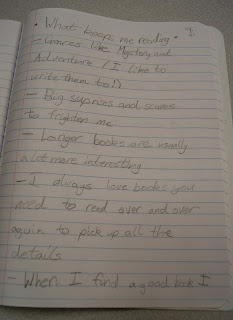I first revisit the State of Michigan GLCE for ELA to check up on the genres that 4th and 5th graders are supposed to be studying. This year I also checked out the Common Core document for ELA. According to the State of Michigan students in the 4th & 5th grade should be studying the following:
- 4th: R.NT.04.02 identify and describe the structure, elements, and purpose of a variety of narrative genre including poetry, myths, legends, fantasy, and adventure.
- 5th: R.NT.05.02 analyze the structure, elements, style, and purpose of narrative genre
including historical fiction, tall tales, science fiction, fantasy, and mystery.
We begin by putting all the genres in a big basket. At the beginning of every month a volunteer student draws out the month's focus. So far this year we've studied mystery, fantasy, and now tall tales. At the same time I teach the students story grammar concepts (setting, characterization, plot, conflict, etc.) during reader's workshop. For this I have been studying the Common Core documents quite a bit, plus I continue to use the state GLCE's for narrative text structure:
- R.NT.05.03 analyze how characters’ traits and setting define plot, climax, the role of
- dialogue, and how problems are resolved.
- R.NT.05.04 explain how authors use literary devices including exaggeration and metaphors to develop characters, themes, plot, and functions of heroes, anti-heroes, and narrators.
- R.NT.04.03 analyze characters’ thoughts and motivation through dialogue, various
character roles, and functions including hero, anti-hero, or narrator; know first person
point of view and identify conflict and resolution.
When the 5th graders and 4th graders made a mystery mobile they each had different assignments. 4th graders had recently studied the story grammar structure so their mobile included characters (main and secondary) analyzed for their traits, setting, problem/solution, and theme. On the other hand, the 5th graders had a completely different set of expectations. Last year they had studied all that and more. Therefore, their mobile included an analysis of characters and a description of setting. Next, they created a story mountain which detailed the climax of the story. They had to identify the four types of conflict within the story (character vs. character, character vs. self, character vs. society, character vs. nature), and give two examples of figurative language found in the story. There may have been more but I've forgotten!
When we do an assignment such as read a mystery and create a mobile the students are given a reading schedule. First, they are told they must have the appropriate genre story by a certain date (usually 2-3 days are given to settle on a book). They sign up for their book and get to reading. I give them a finish the book date and remind them of this date every day in reader's workshop. By the time they finish the book they have post-it marked the book like crazy (Post-its mark examples that will be used to create the project.) and are anxious to begin. In this way we almost never have students with an overdue project. If students are late completing the project it's usually because they picked a book that was too hard, boring, too long, etc. This almost never happens because I catch this early using "state of the class" and reading conferences.
Projects could include creating a book poster, Powerpoint, Prezi, mobile, game, etc. For the month of December students will conduct a "thinkquest" at home assignment to go along with our study of tall tales.
These genre studies are fun and allow us to pack in a lot of work studying narrative text! For those wondering about nonfiction--this is a very big genre unit that typically lasts 8 weeks. We start it as soon as we return from our Christmas break. I'll talk more about that later! For those questioning my focus on genre studies and "making" students read genre that they don't like or have never read before, remember that they will not always have choice in their life. While in middle school or high school, they WILL have to read books/genre/authors that aren't their first choice. This exposure is incredibly important to building a well-rounded reader who thinks critically about the world. I'll close with an example from a former student, Will. He was NOT happy the month he had to read historical fiction. However, at the end of the month he admitted that he'd not only liked the book he'd chosen, he planned to check out another piece of historical fiction by the same author!













